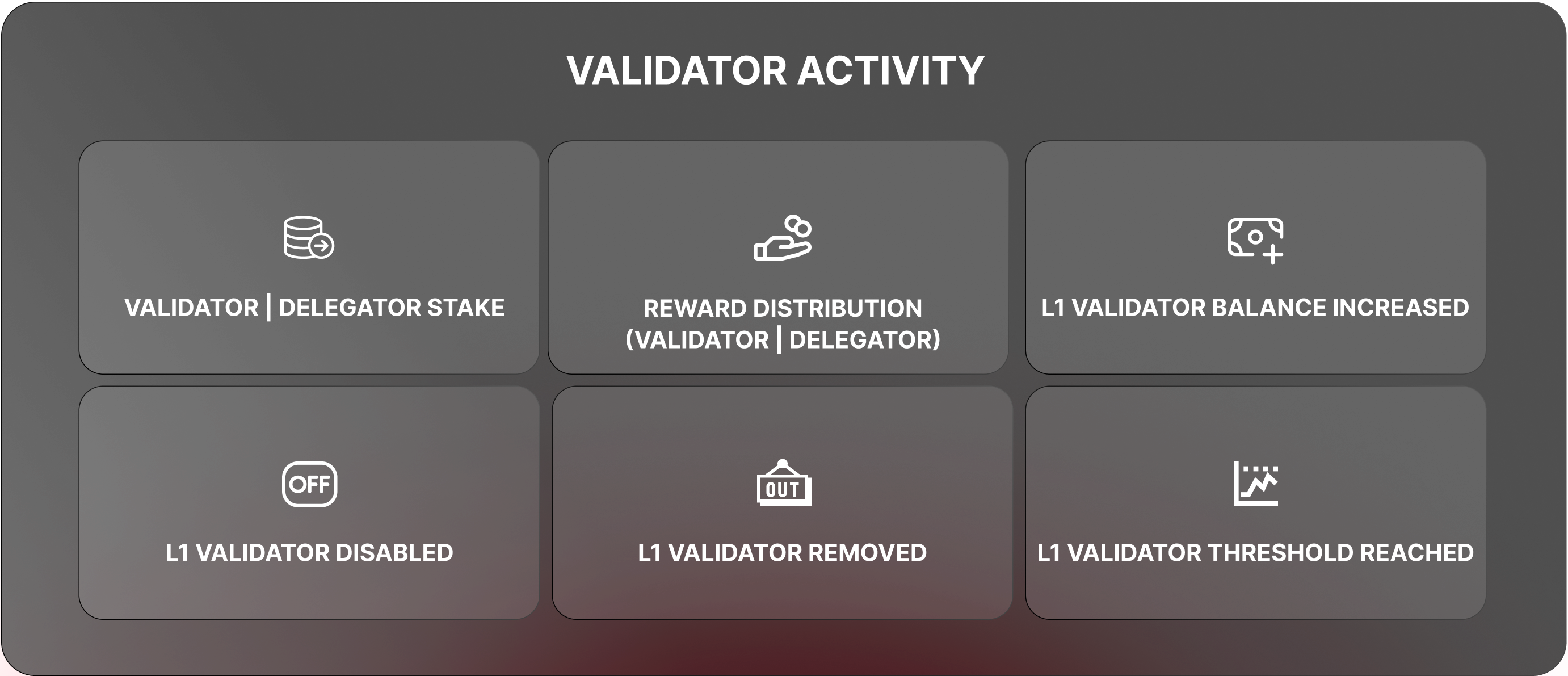{
"webhookId": "89266b1b-61a1-40f7-a309-59af999a048b",
"eventType": "validator_activity",
"messageId": "ee83d3ae-262e-4eb5-992e-6b398f756ef3",
"event": {
"eventType": "reward_distribution",
"nodeID": "NodeID-ARXUBU2TCXBYG7JdCx7ntuPwBf73pHsTN",
"subnetID": "11111111111111111111111111111111LpoYY",
"rewardAddresses": [
"avax10f8305248c0wsfsdempdtpx7lpkc30vwzl9y9q"
],
"amount": "4836372611",
"rewardType": "VALIDATOR",
"rewardTxHash": "iK11FDhbLvNKwXXrzGXE1eQfdWQVHyqjkmh8wiii8DTTZ73nM",
"stakingTxHash": "AwDXauL61FLkaZia7a7vwJdXL8Lv7Bvu8TpfE3PhHYHZ1h3KT",
"rewardTx": {
"txHash": "iK11FDhbLvNKwXXrzGXE1eQfdWQVHyqjkmh8wiii8DTTZ73nM",
"txType": "RewardValidatorTx",
"blockTimestamp": 1742841915,
"blockNumber": "20993987",
"blockHash": "CwbgPKECAGhRYh9xu8GM1PRmNRfRWgVsBJss6YmGMFeMQVvXu",
"memo": "",
"stakingTxHash": "AwDXauL61FLkaZia7a7vwJdXL8Lv7Bvu8TpfE3PhHYHZ1h3KT",
"rewardAddresses": [
"avax10f8305248c0wsfsdempdtpx7lpkc30vwzl9y9q"
],
"nodeId": "NodeID-ARXUBU2TCXBYG7JdCx7ntuPwBf73pHsTN",
"subnetId": "11111111111111111111111111111111LpoYY",
"consumedUtxos": [
],
"emittedUtxos": [
],
"value": [
],
"amountBurned": [
],
"amountStaked": [
],
"amountL1ValidatorBalanceBurned": [
]
},
"stakingTx": {
"txHash": "AwDXauL61FLkaZia7a7vwJdXL8Lv7Bvu8TpfE3PhHYHZ1h3KT",
"txType": "AddPermissionlessValidatorTx",
"blockTimestamp": 1741545923,
"blockNumber": "20885184",
"blockHash": "2NdapVdGtAZFDwruEiEsGihQZnRjesrodKdM3a41anrUsnQdfU",
"memo": "0x",
"rewardAddresses": [
"avax10f8305248c0wsfsdempdtpx7lpkc30vwzl9y9q"
],
"rewardTxHash": "iK11FDhbLvNKwXXrzGXE1eQfdWQVHyqjkmh8wiii8DTTZ73nM",
"estimatedReward": "4836372611",
"startTimestamp": 1741545923,
"endTimestamp": 1742841915,
"delegationFeePercent": "20000",
"nodeId": "NodeID-ARXUBU2TCXBYG7JdCx7ntuPwBf73pHsTN",
"subnetId": "11111111111111111111111111111111LpoYY",
"blsCredentials": {
"publicKey": "0x98b62c058ecde88c860756dd4968434bc6240f70c5af18ed1f5026f82601f94228c4550581fd4196a69674e4b8dfe4be",
"proofOfPossession": "0x96047f55349675ec0e95eaa53a40958f1421654d8cd785e9ca9fc5c3035a897899b362e12e8f03c936644a5e5f7d161a0576a99b064a82b73636f2bf1911e4a115cbc9fed5c5b8ffaf90496cdc11a25121bf077be9d921ee74d9858cd55d2602"
},
"consumedUtxos": [
{
"addresses": [
"avax10f8305248c0wsfsdempdtpx7lpkc30vwzl9y9q"
],
"utxoId": "2PrK8TrzJYDjNfxpY6VRZZKqeLPByFXD2pLoa9rmc29uRwjkKP",
"txHash": "2vFCqjStaE5JaxTixF15xrFnCLojxEgjzNYCYwS3dzGkAwaYPf",
"outputIndex": 0,
"blockTimestamp": 1741545875,
"blockNumber": "20885170",
"consumingTxHash": "AwDXauL61FLkaZia7a7vwJdXL8Lv7Bvu8TpfE3PhHYHZ1h3KT",
"consumingBlockTimestamp": 1741545923,
"consumingBlockNumber": "20885184",
"assetId": "FvwEAhmxKfeiG8SnEvq42hc6whRyY3EFYAvebMqDNDGCgxN5Z",
"asset": {
"assetId": "FvwEAhmxKfeiG8SnEvq42hc6whRyY3EFYAvebMqDNDGCgxN5Z",
"name": "Avalanche",
"symbol": "AVAX",
"denomination": 9,
"type": "secp256k1",
"amount": "2009726891042"
},
"utxoType": "TRANSFER",
"amount": "2009726891042",
"platformLocktime": 0,
"threshold": 1,
"createdOnChainId": "11111111111111111111111111111111LpoYY",
"consumedOnChainId": "11111111111111111111111111111111LpoYY",
"staked": false
},
{
"addresses": [
"avax10f8305248c0wsfsdempdtpx7lpkc30vwzl9y9q"
],
"utxoId": "pUtaoF7X83NsvyMZQi6LtqpeuznGWEnTanqs5jhEcU5kFtuYs",
"txHash": "2fnmPQQGwuiLGbeRdRDr5mNKFgFnQZzjutnvoBgJgCMnZiZFBK",
"outputIndex": 2,
"blockTimestamp": 1740249835,
"blockNumber": "20776402",
"consumingTxHash": "AwDXauL61FLkaZia7a7vwJdXL8Lv7Bvu8TpfE3PhHYHZ1h3KT",
"consumingBlockTimestamp": 1741545923,
"consumingBlockNumber": "20885184",
"assetId": "FvwEAhmxKfeiG8SnEvq42hc6whRyY3EFYAvebMqDNDGCgxN5Z",
"asset": {
"assetId": "FvwEAhmxKfeiG8SnEvq42hc6whRyY3EFYAvebMqDNDGCgxN5Z",
"name": "Avalanche",
"symbol": "AVAX",
"denomination": 9,
"type": "secp256k1",
"amount": "1999999956266"
},
"utxoType": "TRANSFER",
"amount": "1999999956266",
"platformLocktime": 0,
"threshold": 1,
"createdOnChainId": "11111111111111111111111111111111LpoYY",
"consumedOnChainId": "11111111111111111111111111111111LpoYY",
"staked": true,
"utxoStartTimestamp": 1740249835,
"utxoEndTimestamp": 1741545831
}
],
"emittedUtxos": [
{
"addresses": [
"avax10f8305248c0wsfsdempdtpx7lpkc30vwzl9y9q"
],
"utxoId": "2nY9g35whvatF1KcUi9AsjWtPhaotuUvLKAZzU48s3aCU5fHhR",
"txHash": "AwDXauL61FLkaZia7a7vwJdXL8Lv7Bvu8TpfE3PhHYHZ1h3KT",
"outputIndex": 0,
"blockTimestamp": 1741545923,
"blockNumber": "20885184",
"consumingTxHash": "znJoB1bt4thuEaKaXN1V1z6Vy4gPPCaHP8FqmGR6MN1wNwU8F",
"consumingBlockTimestamp": 1741546078,
"consumingBlockNumber": "20885194",
"assetId": "FvwEAhmxKfeiG8SnEvq42hc6whRyY3EFYAvebMqDNDGCgxN5Z",
"asset": {
"assetId": "FvwEAhmxKfeiG8SnEvq42hc6whRyY3EFYAvebMqDNDGCgxN5Z",
"name": "Avalanche",
"symbol": "AVAX",
"denomination": 9,
"type": "secp256k1",
"amount": "1999999912532"
},
"utxoType": "TRANSFER",
"amount": "1999999912532",
"platformLocktime": 0,
"threshold": 1,
"createdOnChainId": "11111111111111111111111111111111LpoYY",
"consumedOnChainId": "11111111111111111111111111111111LpoYY",
"staked": false
},
{
"addresses": [
"avax10f8305248c0wsfsdempdtpx7lpkc30vwzl9y9q"
],
"utxoId": "hzjzv2XnyAo5kQpUzwZGfZQFhdsp5TjDBrUGDg85kR5pk8pJ4",
"txHash": "AwDXauL61FLkaZia7a7vwJdXL8Lv7Bvu8TpfE3PhHYHZ1h3KT",
"outputIndex": 1,
"blockTimestamp": 1741545923,
"blockNumber": "20885184",
"assetId": "FvwEAhmxKfeiG8SnEvq42hc6whRyY3EFYAvebMqDNDGCgxN5Z",
"asset": {
"assetId": "FvwEAhmxKfeiG8SnEvq42hc6whRyY3EFYAvebMqDNDGCgxN5Z",
"name": "Avalanche",
"symbol": "AVAX",
"denomination": 9,
"type": "secp256k1",
"amount": "43734"
},
"utxoType": "TRANSFER",
"amount": "43734",
"platformLocktime": 0,
"threshold": 1,
"createdOnChainId": "11111111111111111111111111111111LpoYY",
"consumedOnChainId": "11111111111111111111111111111111LpoYY",
"staked": true,
"utxoStartTimestamp": 1741545923,
"utxoEndTimestamp": 1742841915
},
{
"addresses": [
"avax10f8305248c0wsfsdempdtpx7lpkc30vwzl9y9q"
],
"utxoId": "2MuasJwJtT7eJHa34d2Vv3WhAMMZtmsMpQdP3NzxpFQwHWPKUo",
"txHash": "AwDXauL61FLkaZia7a7vwJdXL8Lv7Bvu8TpfE3PhHYHZ1h3KT",
"outputIndex": 2,
"blockTimestamp": 1741545923,
"blockNumber": "20885184",
"assetId": "FvwEAhmxKfeiG8SnEvq42hc6whRyY3EFYAvebMqDNDGCgxN5Z",
"asset": {
"assetId": "FvwEAhmxKfeiG8SnEvq42hc6whRyY3EFYAvebMqDNDGCgxN5Z",
"name": "Avalanche",
"symbol": "AVAX",
"denomination": 9,
"type": "secp256k1",
"amount": "2009726855578"
},
"utxoType": "TRANSFER",
"amount": "2009726855578",
"platformLocktime": 0,
"threshold": 1,
"createdOnChainId": "11111111111111111111111111111111LpoYY",
"consumedOnChainId": "11111111111111111111111111111111LpoYY",
"staked": true,
"utxoStartTimestamp": 1741545923,
"utxoEndTimestamp": 1742841915
},
{
"addresses": [
"avax10f8305248c0wsfsdempdtpx7lpkc30vwzl9y9q"
],
"utxoId": "kmmwg1EhQrjmoktSAi7g37ohB5ti8gYiXCyXN4p8LtSbwAffy",
"txHash": "AwDXauL61FLkaZia7a7vwJdXL8Lv7Bvu8TpfE3PhHYHZ1h3KT",
"outputIndex": 3,
"blockTimestamp": 1742841915,
"blockNumber": "20993987",
"assetId": "FvwEAhmxKfeiG8SnEvq42hc6whRyY3EFYAvebMqDNDGCgxN5Z",
"asset": {
"assetId": "FvwEAhmxKfeiG8SnEvq42hc6whRyY3EFYAvebMqDNDGCgxN5Z",
"name": "Avalanche",
"symbol": "AVAX",
"denomination": 9,
"type": "secp256k1",
"amount": "4836372611"
},
"utxoType": "TRANSFER",
"amount": "4836372611",
"platformLocktime": 0,
"threshold": 1,
"createdOnChainId": "11111111111111111111111111111111LpoYY",
"consumedOnChainId": "11111111111111111111111111111111LpoYY",
"staked": false,
"rewardType": "VALIDATOR"
}
],
"value": [
{
"assetId": "FvwEAhmxKfeiG8SnEvq42hc6whRyY3EFYAvebMqDNDGCgxN5Z",
"name": "Avalanche",
"symbol": "AVAX",
"denomination": 9,
"type": "secp256k1",
"amount": "4014563184455"
}
],
"amountBurned": [
{
"assetId": "FvwEAhmxKfeiG8SnEvq42hc6whRyY3EFYAvebMqDNDGCgxN5Z",
"name": "Avalanche",
"symbol": "AVAX",
"denomination": 9,
"type": "secp256k1",
"amount": "35464"
}
],
"amountStaked": [
{
"assetId": "FvwEAhmxKfeiG8SnEvq42hc6whRyY3EFYAvebMqDNDGCgxN5Z",
"name": "Avalanche",
"symbol": "AVAX",
"denomination": 9,
"type": "secp256k1",
"amount": "2009726899312"
}
],
"amountL1ValidatorBalanceBurned": [
{
"assetId": "FvwEAhmxKfeiG8SnEvq42hc6whRyY3EFYAvebMqDNDGCgxN5Z",
"name": "Avalanche",
"symbol": "AVAX",
"denomination": 9,
"type": "secp256k1",
"amount": "0"
}
]
}
}
}
